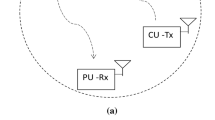Abstract
Spectrum sensing is the quintessence of cognitive radio network and is influenced by uncertain noise at low SNR. In such a scenario sensing duration imposes a constraint on the sensing performance. This paper presents a novel mathematical approach to obtain optimal sensing duration (number of samples) in presence of noise uncertainty for energy detection method. The effect of noise uncertainty on number of sensed samples has been analyzed and a novel approach has been presented to correlate the sensing duration with SNR to attain desired performance in terms of PFA (Probability of False Alarm) and PD (Probability of Detection).







Similar content being viewed by others
References
Valenta, V., Maršálek, R., Baudoin, G., et al. (2010). Survey on spectrum utilization in Europe: Measurements, analyses and observations. In CROWNCOM (pp. 1–6). Cannes, France.
Federal Communications Commission. (2004). Notice of proposed rule making, FCC 04-113: Unlicensed operation in the TV broadcast bands (ET Docket No. 04-186). Retrieved May 25, 2004, from http://www.fcc.gov/sptf/headlines2004.html.
Mitola, J., & Maguire, G., Jr. (1999). Cognitive radio: Making software radios more personal. IEEE Personal Communications,6(4), 13–18.
Haykin, Simon. (2005). Cognitive radio: Brain-empowered wireless communications. IEEE Journal on Selected Areas in Communications,23(2), 201–220.
Letaief, K. B., & Zhang, W. (2009). Cooperative communications for cognitive radio. Proceedings of the IEEE,97(5), 878–893.
Vadivelu, K. S. R., & Vijayakumari, V. (2014). Matched filter based spectrum sensing for cognitive radio at low signal to noise ratio. Journal of Theoretical & Applied Information Technology, 62(1), 107–113.
Hosseini, S. M. A. T., Amindavar, H., & Ritcey, J. A. (2010). A new cyclo-stationary spectrum sensing approach in cognitive radio. In Proceedings of IEEE SPAWC’10, Marrakech (pp. 1–4).
Tian, Z., & Giannakis, G. B. (2006). A wavelet approach to wideband spectrum sensing for cognitive radios. In Proceedings of CROWNCOM’06, Mykonos Island, Greece.
Zeng, Y., & Liang, Y. C. (2007) Covariance based signal detections for cognitive radio. In Proceedings of IEEE international symposium on new frontiers in dynamic spectrum access networks, Dublin, Ireland (pp. 202–207).
Yucek, T., & Arslan, H. (2009). A survey of spectrum sensing algorithm for cognitive radio applications. IEEE Communication Survey & Tutorials,11(1), 116–130.
Urkowitz, H. (1967). Energy detection of unknown deterministic signals. Proceedings of the IEEE,55(4), 523–531.
Digham, F. F., Alouini, M. S., & Simon, M. K. (2003). On the energy detection of unknown signals over fading channels. In Proceedings of IEEE ICC’03 (pp. 3575–3579).
Yu, G., Long, C., & **ang, M. (2012). A novel spectrum detection scheme based on dynamic threshold in cognitive radio systems. Research Journal of Applied Sciences, Engineering and Technology,4(21), 4245–4251.
Chabbra, K., Mahendru, G., Banerjee, P. (2014). Effect of dynamic threshold and noise uncertainty in energy detection spectrum sensing technique for cognitive radio systems. In Proceedings of the IEEE international conference on signal processing and integrated networks (SPIN), India (pp. 361–377).
Tandra, R., & Sahai, A. (2008). SNR walls for signal detection. IEEE Journal of Selected Topics in Signal Processing,2(1), 4–17.
Yin, W., Ren, P., Cai, J., & Su, Z. (2013). Performance of energy detector in the presence of noise uncertainty in cognitive radio networks. Wireless Networks,19(5), 629–638.
Shellhammer, S. J. (2008). Spectrum sensing in IEEE 802.22. In 1st IAPR workshop on cognitive information processing.
Cacciapuoti, A., Caleffi, M., Marino, F., & Paura, L. (2014). Sensing-time optimization in cognitive radio enabling smart grid. In Proceedings of EMTC (pp. 1–6).
Arar, A., Masri, A., & Ghannam, H. (2017). A proposed scheme for dynamic threshold versus noise uncertainty in cognitive radio networks (DTNU). Wireless Personal Communication,96, 4543–4555.
Avila, J., & Thenmozhi, K. (2015). Enrichment of adaptive threshold in cognitive radio. Asian Journal of Scientific Research,8, 333–341.
Zhu, J., Xu, Z., Wang, F., Huang, B., & Zhang, B. (2008) Double threshold energy detection of cooperative spectrum sensing in cognitive radio. In Proceedings on international conference on cognitive radio oriented wireless networks and communications CrownCom‘08 (pp. 1–5).
**e, J., & Chen, J. (2012). An adaptive double-threshold spectrum sensing algorithm under noise uncertainty. In 2012 IEEE 12th international conference on computer and information technology, Chengdu (pp. 824–827).
Verma, P., & Singh, B. (2016). On the decision fusion for cooperative spectrum sensing in cognitive radio networks. Wireless Networks, 23(7), 1–10.
Atapattu, S., Tellambura, C., & Jiang, H. (2011). Spectrum sensing via energy detector in low SNR. In Proceedings of IEEE ICC (pp. 1–5).
Kay, S. M. (1993). Fundamentals of statistical signal processing: Estimation theory. Upper Saddle River, NJ: Prentice-Hall Inc.
He, Y., Martin, R., & Bilgic, A. M. (2010). Approximate iterative least squares algorithms for GPS positioning. In Proceedings of the IEEE international symposium on signal processing and information technology (ISSPIT ‘10), Luxor, Egypt (pp. 231–236).
Söderström, T., & Stewart, G. W. (1974). On the numerical properties of an iterative method for computing the Moore–Penrose generalized inverse. SIAM Journal on Numerical Analysis,11(1), 61–74.
Author information
Authors and Affiliations
Corresponding author
Additional information
Publisher's Note
Springer Nature remains neutral with regard to jurisdictional claims in published maps and institutional affiliations.
Rights and permissions
About this article
Cite this article
Mahendru, G., Shukla, A. & Banerjee, P. A Novel Mathematical Model for Energy Detection Based Spectrum Sensing in Cognitive Radio Networks. Wireless Pers Commun 110, 1237–1249 (2020). https://doi.org/10.1007/s11277-019-06783-3
Published:
Issue Date:
DOI: https://doi.org/10.1007/s11277-019-06783-3




